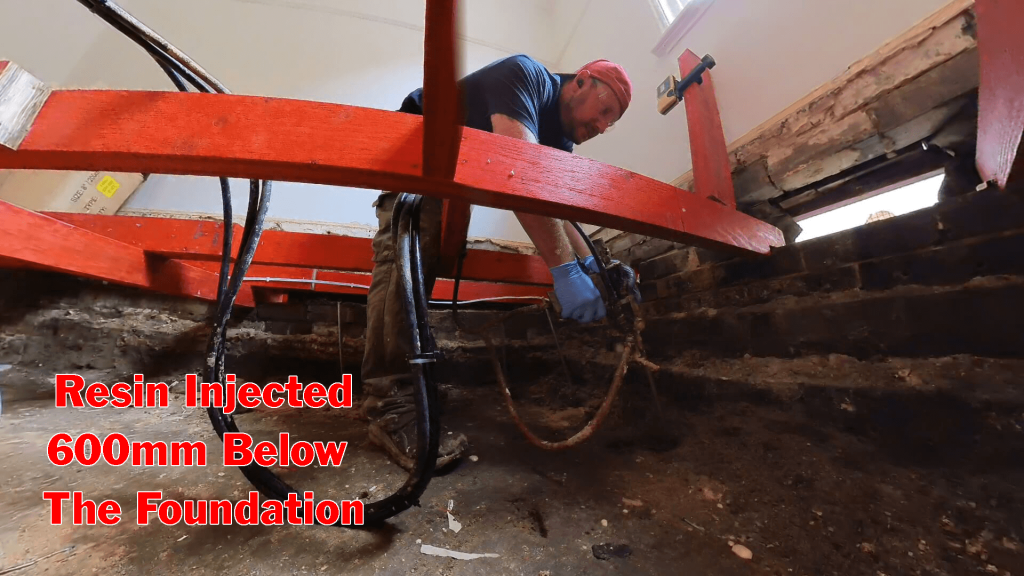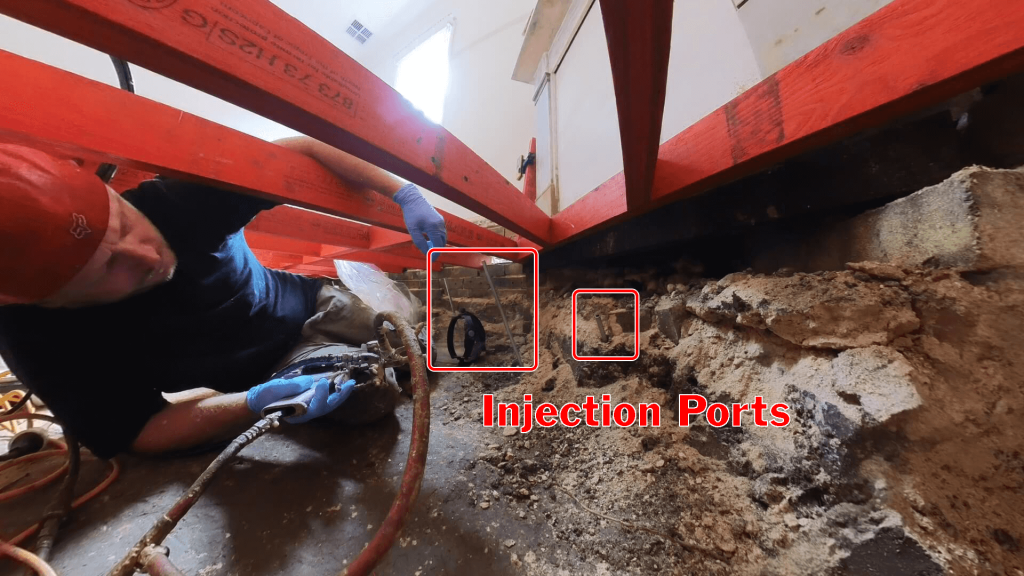Underpinning Foundations
With Resin Injection
...the fastest way to underpin
& stop your building from sinking.
Benefits Summary
Here’s why people choose resin injection for underpinning;
- It’s super fast.
- Usually no excavation is required.
- It’s solid (80mpa).
- The resins have a 50 year warranty.
- It is versitile and can be used in many underpinning situations from subsidence to foundation jacking & void filling.
- Resin can be shaped and creatively injected into locations that that concrete and grout can’t reach.
- We can inject deeper into the ground than you would normally excavate to get very deep and solid underpinning.

What is Underpinning?
Sinking foundations can jeopardize the structural integrity and safety of a building.
This occurs when the foundation gradually settles or sinks into the ground, leading to a variety of problems.
Understanding the causes, signs, and potential solutions for sinking house foundations is crucial for homeowners to protect their investment and ensure the stability of their property.
- Cracks in Walls: Visible cracks may appear on the foundation walls, floors, or ceilings. These cracks can be horizontal, vertical, diagonal, or stair-step patterns, indicating foundation movement.
- Uneven Sinking Floors: Sinking foundations can cause floors to slope or become uneven, leading to noticeable changes in the levelness of the house.
- Doors and Windows Sticking: As the foundation settles, doors and windows may start to stick or become difficult to open or close properly.
- Separation of Walls and Trim: Sinking foundations can cause gaps to form between walls, ceilings, and trim, indicating movement and settlement.
- Uneven Bricks: You may see the lines of mortar in your brickwork with dips along them or curving down towards the corner of the building.
Resin Underpinning for Walls & Foundations
Provides Solid Volume, & Mass Support

Don't Dig... Inject!
Strong But Light Weight
Did you know: Using materials with high mass can add additional weight to an area that is already suffering from subsidence?
If you choose Polyurethane resins it means you can get the same result as concrete underpinning without the risk of weight impact.
Polyurethane resins are light weight but also very strong. High strength and light weight means no risk of causing the compounding effect you could get from the additional mass of traditional concrete underpinning.
Because resin injection is much faster it means you won’t get held up waiting for underpinning.
Now Enter Your Details Below
Resin Injection Underpinning is the Fastest and Least Invasive Way to Stop Your Foundations From Sinking.

So Why Do Foundations Sink?
1
Subsidence
Subsidence, occurs when the ground sinks or settles downward. This can happen for various reasons, but it often involves the collapse of underground materials or the withdrawal of fluids from beneath the surface.
Compaction
2
Activities such as construction, the installation of underground infrastructure (like tunnels or sewers), or the placement of heavy structures on the surface can cause the soil to compact over time.
3
Natural Processes
Natural processes such as dissolution of soluble rocks (like limestone), and the natural settling of sediment can cause the ground to subside gradually over time.
Groundwater Withdrawal
4
“subsidence due to groundwater withdrawal” happens when groundwater is removed leading to the compaction and settling of the ground above. This can happen by ground water naturally drying or changes in below ground waterflow or drainage.
5
Water Saturation
Water events can infiltrate and saturate sediment layers, causing them to become softer and more prone to compaction. Over time, this softening can contribute to subsidence, particularly with repeated saturation events.
Erosion
6
Waters can erode soil and sediment from beneath structures, roads, and other infrastructure, leading to voids or empty spaces underground. As these voids collapse or fill with water, the ground above may sink, causing localized subsidence.
7
Neighboring Construction
Excavation for foundations and basements can destabilize the ground. This disturbance can lead to soil compaction and settling, causing subsidence in neighboring properties as the soil adjusts to the changes.
Vibration
8
Heavy construction machinery or newly installed roads can generate vibrations that propagate through the ground. These vibrations can compact loose soil, displace sediments, and disturb underground structures, potentially leading to subsidence over time.
Injection Rods Allow Us To Inject Deep Under Your Footings to Provide Solid Mass Support

Enter your details
If you’re worried about your building cracking, sinking and having wavey mortar lines in your brickwork then why not get in touch.
We can have a quick chat over the phone and gather some information to see if we can help you, then if you’d like we can book in a time to come and see your building.
No pressure, no fear selling. We’ll just provide infomation so you can make a well informed decision.
The Most Common Causes of Sinking House Foundations We Encounter
- Poor Soil Compaction During Construction: If the soil beneath the foundation was not adequately compacted during construction, it can compress or shift over time, causing the foundation to sink.
- Soil Erosion: Water runoff, poor drainage, or plumbing leaks can erode the soil around the foundation. As the soil washes away, it creates empty spaces or voids, compromising the foundation's support.
- Subsidence: Natural or human-induced subsidence occurs when the ground beneath the foundation sinks or collapses due to factors such as groundwater withdrawal, improper excavation, or soil consolidation.
Enter your details now & get a call-back.
Fix Your
Sunken Foundations
It is essential to consult with a professional foundation repair specialist or to assess the extent of the problem and recommend the most appropriate solution for sinking house foundations. Taking prompt action can prevent further damage and ensure the long-term stability and safety of your home.





















